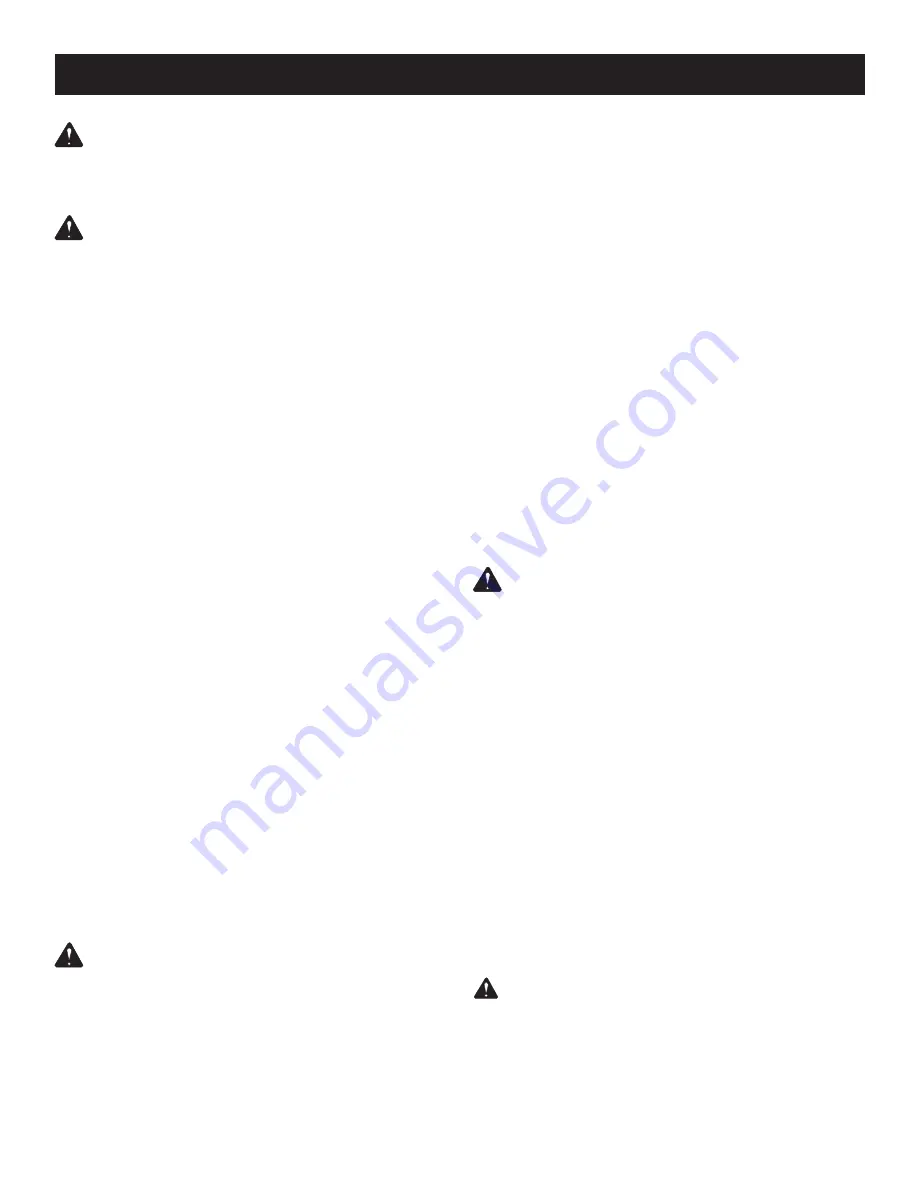
10 – English
OPERATION
WARNING:
Do not allow familiarity with tools to
make you careless. Remember that a careless
fraction of a second is sufficient to inflict serious
injury.
WARNING:
Always wear eye protection with side
shields marked to comply with ANSI Z87.1. Failure to
do so could result in objects being thrown into your
eyes resulting in possible serious injury.
APPLICATIONS
You may use this tool for the following purposes:
Cutting all types of wood products (lumber, plywood,
paneling, composition board, and hardwood)
INSTALLING BATTERY PACK
See Figure 5, page ii.
NOTE:
Battery pack is shipped in a low charge condition.
Therefore, it must be charged prior to use.
Place battery pack in the saw. Align raised rib on
battery pack with groove inside saw, then slide battery
pack in saw.
Make sure the latches on each side of the battery pack
snap into place and battery pack is secured in saw
before beginning operation.
NOTICE:
When placing battery pack in the saw, be
sure raised rib on battery pack aligns with groove
inside saw and latches snap into place properly.
Improper assembly can cause damage to saw and
battery pack.
REMOVING BATTERY PACK
See Figure 5, page ii.
Locate latches on side of battery pack and depress to
release battery pack from the saw.
Remove battery pack from the saw.
KICKBACK
See Figures 6 - 9, page ii.
Kickback occurs when the blade stalls rapidly and the saw
is driven back toward you. Blade stalling is caused by any
action which pinches the blade in the wood.
DANGER:
Release switch immediately if blade
binds or saw stalls. Kickback could cause you to
lose control of the saw. Loss of control can lead to
serious injury.
To guard against kickback,
avoid dangerous practices
such as the following:
Setting blade depth incorrectly.
Sawing into knots or nails in workpiece.
Twisting the blade while making a cut.
Making a cut with a dull, gummed up, or improperly set
blade.
Supporting the workpiece incorrectly.
Forcing a cut.
Cutting warped or wet lumber.
Operating the tool incorrectly or misusing the tool.
To lessen the chance of kickback,
follow these safety
practices:
Keep blade at the correct depth setting. The depth setting
should not exceed 1/4 in. below the material being cut.
Inspect the workpiece for knots or nails before cutting.
Never saw into a knot or nail.
Make straight cuts. Always use a straight edge guide
when rip cutting. This helps prevent twisting the blade.
Use clean, sharp, and properly set blades. Never make
cuts with dull blades.
Support the workpiece properly before beginning a cut.
Use steady, even pressure when making a cut. Never
force a cut.
Do not cut warped or wet lumber.
Hold the saw firmly with both hands and keep your body
in a balanced position so as to resist the forces if kickback
should occur.
WARNING:
When using the saw, always stay alert
and exercise control. Do not remove the saw from
the workpiece while the blade is moving.
SAW BLADES
The best of saw blades will not cut efficiently if they are
not kept clean, sharp, and properly set. Using a dull blade
will place a heavy load on the saw and increase the dan-
ger of kickback. Keep extra blades on hand, so that sharp
blades are always available.
Gum and wood pitch hardened on blades will slow the
saw down. Remove saw blade from the saw and use gum
and pitch remover, hot water, or kerosene to remove these
accumulations.
DO NOT USE GASOLINE.
BLADE GUARD SYSTEM
See Figure 10, page ii.
The lower blade guard attached to the trim saw is there for
your protection and safety. Do not alter it for any reason.
If it becomes damaged, do not operate the saw until you
have the guard repaired or replaced. Always leave guard
in operating position when using the saw.
DANGER:
When sawing through work, lower
blade guard does not cover blade on the underside
of work. Since blade is exposed on underside of
work, keep hands and fingers away from cutting
area. Any part of your body coming in contact with
moving blade will result in serious injury.
Summary of Contents for 315.114261
Page 31: ...14 Español NOTAS ...
Page 32: ......











































